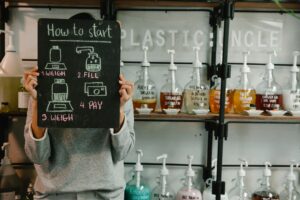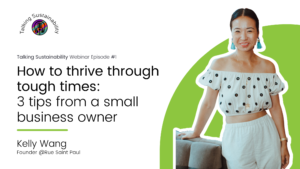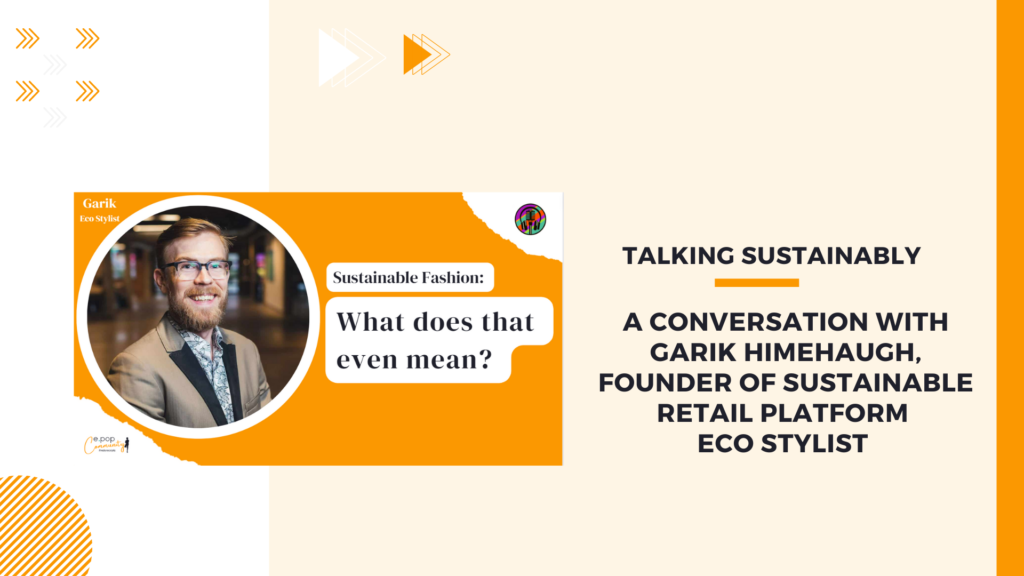In today’s episode, we chatted with Garik Himebaugh, founder of Eco Stylist, about sustainable fashion. Every year, consumers are purchasing more clothing per person than ever before. In this conversation, we talked about greenwashing and how you can spot fashion brands that are sustainable.
“I enjoy thinking about innovative ways to solve ambiguous problems. Excited about design thinking and social entrepreneurship.” – Garik
In this webinar Q&A with Garik, the founder of the sustainable fashion platform, Eco Stylist, we discuss:
- Meaning of sustainable fashion
- What is Greenwashing
- How to identify a sustainable brand
- Tips to make more conscious choices
Watch the webinar below or on our youtube channel.
About Eco Stylist
Eco Stylist was founded as a way to allow men into the sustainable fashion conversation, providing direction to find ethically sourced apparel directly from their platform. As one might imagine, it has evolved over time to be a comprehensive platform – while still keeping to its mission to promote sustainable fashion choices.
About Talking Sustainability
Sustainability can be daunting, overwhelming, and full of jargon. Talking Sustainably is a series of live discussions with entrepreneurs and companies focused on living more sustainably, either through their business models or personal lifestyles. We want to connect you with companies that are changing the way we live and talk about how they are making positive changes in the world. We’re here to fuel your own conscious lifestyle choices. Tune in to listen to conversations with founders of companies that are changing the way we use and consume products.
You can also watch it on our Youtube channel. You can find the whole transcription below.
About e.pop
Changing the way people and companies think about receipt and contactless solutions is what drives e.pop. Our mission is to build a community of forward-thinking companies and consumers unified in becoming carbon negative and ditch paper receipts altogether. We have started a movement to drive environmental change and innovation keeping all of us better organized and putting trees back where they belong.
Listen to our other episodes
Let Us Know
Liked this episode? Please share the link with your friends and contacts. 🙌
What did you think of these webinars? We’re keen to hear from you – get in touch with us on LinkedIn, Youtube, Facebook, or Instagram
Complete transcription of A conversation with Garik Himehaugh, Founder of sustainable retail platform Eco Stylist
What does sustainability mean to you?
I think when I think of sustainability, I really just think of consuming more responsibly. There’s the environmental aspect of it – consuming in a way that we’re conscious of climate change finite resources of our planet and protecting them but then there’s also the idea of doing no harm and that means not using people because people are a part of sustainability as well. So ensuring that people are treated fairly. (not verbatim) So I think of consuming in a way that is responsible for the people and the planet.
How did Eco Stylist get started?
Eco Stylist is a resource for ethical fashion. As a small start-up we’re not at all what we started out as. It’s been constantly about learning and evolving and changing. It started as a fashion solution, that didn’t really involve sustainability. I just wanted to make it easier for people to shop for things. People had trouble finding specific things and I thought ‘ I think we can help them’.
Then I learned about sustainability. I learned about a brand, first, that was paying fair wages, and just realized that brands could do that on their own. Like have dedication and publish their wages and things. So after that, I was like ‘I’m gonna help people find clothes. I want it to be those kinds of clothes. I want to have them support these “good” brands, these kinds of companies.”
We started with just men’s because there were no solutions for men’s clothes. In the sustainability space. We saw a lot of solutions that were focused on women’s clothes and sustainability or sustainable fashion is a movement that is generally led by women so it makes sense, but obviously, if we want to help everybody consume more responsibly there have to be solutions for men also. So that’s where we started and eventually, we opened it up to women’s clothes as well, because 90% of our brands have women’s clothes as well and a lot of our users are women so it made sense. We still have a very strong offering of men’s clothes but we can still help anybody looking for good, sustainable brands.
It’s a resource. We do brand readings. So we research brands and that’s our most popular resource. So people use our directory as a trusted source of good brands and view those ratings, and we have guides in our blogs and we have a shop as well, where we curate items to make it easier for people to find stylish items from these brands.
What is sustainable fashion (what would you define sustainable fashion as)?
It’s often defined in very singular ways like sustainable fashion is only thrifting and it can’t be anything else or it’s only new brands and it can’t be anything else and the reality is that none of that is true. We have to think of sustainable fashion in a way that’s more inclusive. Not everybody has the same budget and the same preferences. Some people prefer buying new, some people prefer buying new. Sustainable fashion, to me, is any choice that is more conscious. That’s different for most people. What works for you may not for somebody else. Sustainable fashion is this spectrum of good choices. It starts with wearing what you have, making it last. That really reduces the impact, especially in a world where so many clothes are thrown away every year. Then thrifting, swapping, supporting/buying from sustainable ethical brands, mending your clothes when they’re worn instead of tossing them. So it’s this spectrum of sustainable fashion choices that help challenge where we find ourselves today in 2022 with fast fashion and fashion becoming actually less sustainable overall. So sustainable fashion is making choices that challenge that and that are better for the planet and people.
What is greenwashing?
Greenwashing has become really problematic in this space because it’s so pervasive that people no longer know what is sustainable or what is sustainable fashion. It really muddy’s the water. At its core, greenwashing is when brands lie or exaggerate about their impact, with the primary motive behind that to sell products. Sometimes it’s black and white, but sometimes it’s grey. [Makes it hard for people to determine] ‘what is greenwashing and what is not’.
U can give you some really black and white examples. H&M has been called out a lot for greenwashing. In some of the ways they’ve done it it’s really black and white. Like they had this Billie Eilish collection and had this press release where they had these really bold claims like ‘It’s 100% sustainable’ and they immediately got criticized for it. So they hid their press release – they did al these shady things. Like took it down. And at the end of the day, there was no substance [to back] what is said. There was no evidence that this collection was even making an effort to be sustainable. So that’s an example of greenwashing.
In other industries, you see it [happening] in other interesting ways. Like oil companies put out these quizzes. Like ‘learn how you can live a more sustainable life’. And people lose their minds over this kind of stuff because ‘you [oil companies] are responsible for so much of the negative impact on the environment and you’re asking the individual to think about their impact?!’ So that’s a very interesting example of greenwashing. I think it was Dowd Chemical who did that too and Schell has been called on for greenwashing, in that way.
Where it gets more grey is, for example, when you look at H&M’s recycling program. Because it seems to have a good impact, and you could argue this either way, but at the end of the day they aren’t slowing down their consumption. So they’re still producing millions and millions of garments every year and essentially, you can argue, that their recycling program is designed just to make you feel better about what they’re doing and to make you buy more – because they give you a coupon to buy more of their clothes. So what looks good, when you actually look behind it, at their motives, can actually be argued as greenwashing. I would argue that as greenwashing. Because we really can’t [view] brands as sustainable if they don’t consider their consumption. The biggest impact any brand has is their consumption, the amount their produce, and fast fashion brands obviously produce the most.
What is a sustainable brand?
Within the fashion industry specifically, we use the lens of looking at the brand’s level of transparency, their fair labor, and their environmental impact. So we break it down into thinking about those three areas of fashion. Obviously, this is going to be different for different industries. I think the people and the environment are pretty self-explanatory but the reason the transparency is in there is that, in the fashion industry, lack of transparency has been the reason people have been exploited – unfair labor practices, unfair wages – and the environment too – like the documentary River Blue talks about all the chemicals that are dumped in the river. It was a lack of transparency that was allowing those practices to happen. Like the companies, say Gap, for example, had factories that were doing that, it was so buried, they were doing so much to hide this that it was almost impossible to tie the company dumping the chemicals with the brand that was ordering the clothes. So, in fashion, you have to make things more transparent in order to make them more sustainable. It’s sort of like a building block. That’s how I think of sustainability and how we think of it [at Eco Stylist]. With the criteria that we use to research brands, those three pillars are at the core of it and I think that’s what a sustainable brand does. The only addition I would make to that is, that I don’t think a fast-fashion brand could ever be sustainable, even if they hit those three pillars unless they consider their consumption.
How can individuals make more conscious decisions?
The most important thing to do is just to start somewhere. There are obviously a million good things we could do but we can’t do them all. So honestly, I think [..] just start somewhere, try to do something. And what that looks like can depend on you – what you can do, what you have time for, what you care about more. So, for example, making a commitment to not buying anything for 6-9 months is something a lot of people have been doing recently. Or when you need something new, trying to thrift that instead of shopping for it, or replace fast fashion with thrifting. Or, when you need to buy something new, supporting an ethical or sustainable brand, trying to support things that might be happening in your community like clothing swaps. Especially in big cities, like New York, these opportunities are a little more available (clothing swaps can be hard to find in some places). And then, for example, maybe you can try to rent a piece because you’re only going to wear it once. So these are all things we can do to make more conscious choices. But also, being an activist is another one. You could sign a petition, you could see what advocacy campaigns are going on (like Fashion Revolution), or [look into] brands that might have these projects that you can partake in. This might even mean reaching out to brands. Any of these can help push the fashion industry toward a more sustainable future.
You Might Also Be Interested In

How To Avoid Greenwashing—No Matter What You’re Marketing
What is greenwashing? It’s getting a big, green checkmark for an eco-effort that maybe isn’t as meaningful as it seems. It’s when a business takes

Green Guide: How to Open a Zero Waste Store
In our fast-paced, consumption-driven society, convenience is king. And it comes heavily packaged. While vacuum-sealed avocados and the dreaded box-within-a-box-within-a-box may make great viral photographs,

What does Sustainability Mean? Tips to run a low-impact business
Sustainability is becoming increasingly important. Not only for the environment but also for business! Businesses have the power to make a difference when it comes

How to thrive through tough times: 3 tips from a small business owner
2021 brought about many new and exciting things, one of them being our new webinar series, Talking Sustainability! Here, we chat with business owners and industry

Small Business Forecast: Sustainability in Retail 2022
It’s January, which means many folks are making New Year’s resolutions for 2022. As individuals, we may resolve to live healthier or spend more time

6 Ways Small Businesses Can Support Green Friday (Without Closing!)
Black Friday marks the unofficial start of the holiday shopping season in the US and many other countries. In recent years, retailers have begun slashing

